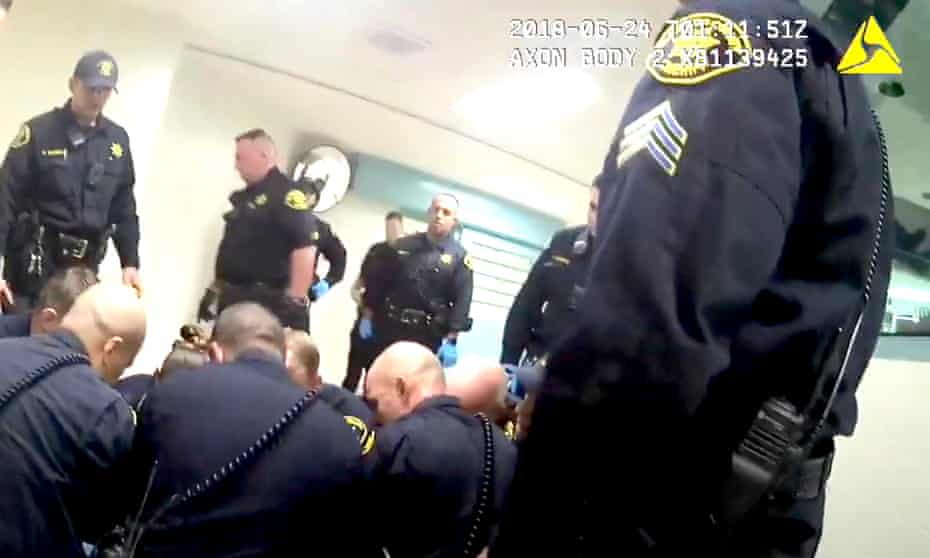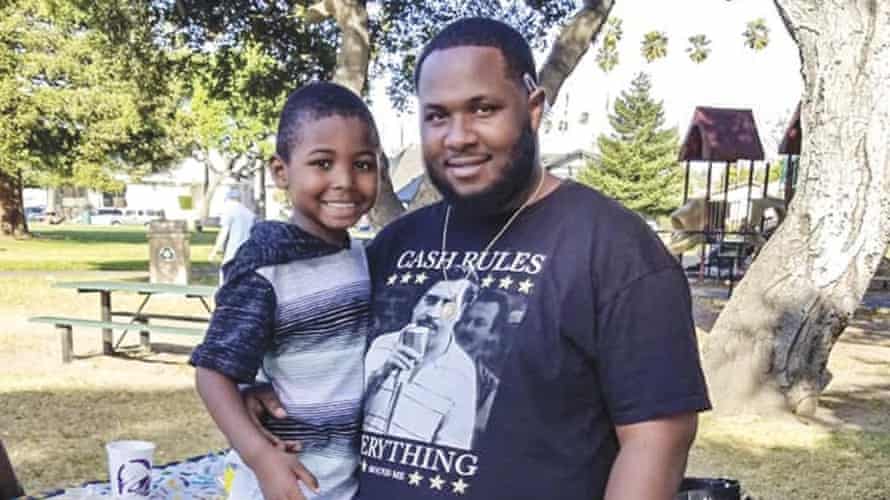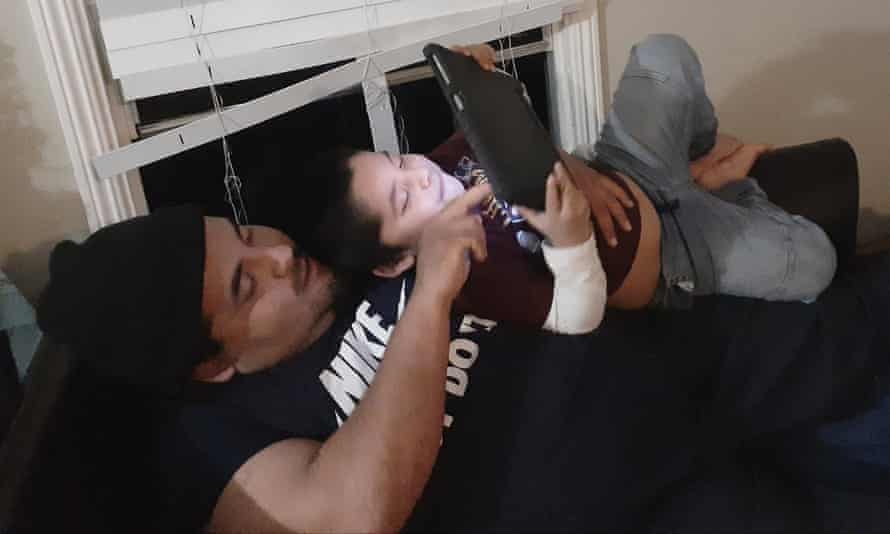They kill the person twice’: police spread falsehoods after using deadly force, analysis finds

“A review of California cases shows that law enforcement frequently publish highly misleading information about people they’ve killed – just like the first George Floyd press release
Last modified on Wed 19 May 2021 06.01 EDT
On the day of George Floyd’s killing, Minneapolis police published a short press release titled “Man Dies After Medical Incident During Police Interaction”.
The news alert on 25 May said an unnamed man “appeared to be suffering medical distress” and died soon after at a hospital, making no mention of the officer kneeling on his neck. The statement has since sparked national backlashas an example of police flagrantly misrepresenting a murder committed by an officer.
That press release, however, was not unique.
A review of police killings in California showed that law enforcement spokespeople frequently publish highly misleading or sometimes false information about the people they have killed. Over the last five years, the Guardian found at least a dozen examples in the state of initial police statements misrepresenting events, with major omissions about the officers’ actions, inaccurate narratives about the victims’ behaviors, or blatant falsehoods about decisive factors.
In some cases, police cited vague “medical emergencies” without disclosing that officers had caused the emergencies through their use of force. In others, departments falsely claimed that the civilians had been armed or had overdosed. In most instances, media outlets repeated the police version of events with little skepticism.
The inaccuracies were exposed by body-camera footage, autopsy reports or litigation records, sometimes only years later. The widespread occurrence of police claims being disproven after the fact suggests that the problem is systemic, and that without public scrutiny or lawsuits, falsehoods are likely to go undetected.
“The press release about George Floyd was not an anomaly,” said Jody David Armour, a University of Southern California law professor and expert on policing. “This is ordinary operating procedures for police departments across the nation.”

Blaming a ‘medical incident’
After Dujuan Armstrong, 23, died inside Santa Rita jail in the Bay Area on 24 June 2018, the Alameda county sheriff reported it as a “drug overdose”. A spokesman told reporters that Armstrong, who had to report to jail on the weekends to complete a 120-day sentence, was acting “bizarre”, saying: “The deputies saw him in distress. They called medics immediately.”
A year later, authorities released a fuller account and they later published body-camera footage, revealing that deputies had strapped Armstrong in a full-body restraining jacket and put a spit mask over his head while transporting him within the jail. The coroner determined Armstrong died of asphyxiation due to the tight restraint device around his abdomen and the spit mask covering his mouth and nose. Despite police’s initial statements, there was no overdose.
“It was so horrible, it was nothing but lies,” said Barbara Doss, Armstrong’s mother. She recalled that authorities had given her very little information in the days after her son’s death, other than suggesting it was an overdose.
“They knew that they were wrong. That’s why they said my son overdosed. They were trying to cover up what they did,” she said, adding that her son, a father of three, was struggling with mental health challenges.
Fatal encounters that don’t involve shootings, such as stun gun deaths or asphyxiation, are often labeled as “medical” incidents or “in-custody deaths”, with news releases emphasizing alleged criminal actions by the individual but providing little or no information about police using force.
“When you say ‘medical emergency’, nobody pays attention. The purpose is to prevent public outcry,” said Melissa Nold, a Bay Area civil rights lawyer who represents victims of police brutality, adding: “There are so many cases that would have caused national outrage, but it comes across as benign in the press release.”
Leaving out key details
When deputies killed Chinedu Okobi, 36, in San Mateo in 2018, the sheriff’s first statement said a man “was running in and out of traffic” and “immediately assaulted the deputy” who tried to contact him. The deputy was hospitalized, the statement said, adding: “The suspect was also transported to the hospital, where it was later learned that he died.”
Dash-cam and witness footage and law enforcement’s own investigations later revealed that Okobi was on the sidewalk when an officer approached to stop him for alleged jaywalking, and it was then that he walked away into the street. Later, a group of officers tried to detain Okobi and repeatedly fired their Taser guns at him, causing him to fall and scream in pain. After an officer hit him with a baton, Okobi struck back at the officer. Officers then pepper-sprayed him and held him down, and he became unresponsive.
The coroner ruled Okabi’s death a homicide, citing the Taser shocks and being physically restrained. The first press release had made no mention of the shocks, and neither did some local news articles, including one that was headlined “Deputy Injured, Suspect Dead”.
“They kill the person twice. The police killed him, and then their statement kills his reputation,” said Ebele Okobi, Chinedu’s sister. “They painted a picture of my brother as a wild, aggressive person, that they had no choice but to kill him. And because he’s dead, he can’t speak for himself. So that’s the image that lodges in the public.”
Violent arrests in which the press releases cited medical distress while downplaying or entirely excluding references to use of force have occurred in Hayward, where a man seeking mental health treatment shouted “I can’t breathe” while held on the ground; Antioch, where a man who had called police for help was restrained with his face in the dirt; Sacramento, where a man was shot by a Taser weapon and beaten into a coma, leading to the city’s largest police violence settlement; San Diego, where a man died with a police officer’s knee to his neck; and Alameda, in two separate deaths.
“To me, ‘medical distress’ means someone is having an asthma attack and we can get them help,” said Anne Gattenby, whose brother Shelby died after Alameda police shot him five times with a stun gun and restrained him on his stomach in 2018. Police initially said he had gone into “distress for unknown reasons”. “It’s wrong to steal somebody’s loved one and then put them through the wringer and use this language to cover your ass so it doesn’t make you seem like the bad guy. It’s not OK.”
Last month, the Alameda police department pinned Mario Gonzalez to the ground for five minutes until he lost consciousness and died. The first press release described a “medical emergency”.

‘They made my brother out to be a monster’
Alicia Saddler has spent years trying to correct the record of her brother’s killing by Vallejo police.
On the night of 23 January 2017, Saddler and her 20-year-old brother, Angel Ramos, and other relatives were hanging out for a small gathering at the family’s home when a fight broke out between a few of the young men. Police showed up and used their Taser devices on multiple people, with one officer shooting Ramos in the neck and chest while he appeared to be fighting a 16-year-old family friend.
Saddler was repeatedly shot with a stun gun and taken to jail for misdemeanor “obstructing a public officer”. She learned her brother had died while in jail and then hours later, upon her release, saw the news reports.
“Officer fatally shoots suspect in knife attack of teen boy,” read one headline. “21-Year-Old Knife-Wielding Man Dead After Officer-Involved Shooting,” said another.
Reporters were relying on the short police press release, which said a “21 year old male was holding a knife and presented himself as an immediate and lethal threat”, and that he was “observed attacking a victim … [who was] a 16 year old juvenile”.
“I was just in disbelief. My brother was murdered and I come home from jail to hear news stations saying that cops killed a man for attempting to stab a child,” Saddler recalled. “I was disgusted and angry because they made my brother out to be a monster. How can you take my brother’s life, and then turn around and make up such a big lie about him? And everybody believed it.”
Her family’s litigation revealed the truth: no knife was recovered near her brother. What’s more, two officers on the scene (who did not shoot Ramos) said they had not seen him holding a knife. Two paramedics who showed up after the killing also said they had seen no knife near his body. And the teenage victim told police and later testified that Ramos didn’t have a knife.
In litigation, the police officer who killed Ramos has maintained that he did have a knife.
When another Vallejo police officer, Ryan McMahon, fatally shot Ronell Foster, 33, in February 2018, the department released a statement saying Foster had fled an “investigative stop” and, in a physical struggle, “armed himself” with the officer’s “metal flashlight … presenting it in a threatening manner”. It said the policeman had fired in “self defense”.
But the body-cam footage appeared to show the officer striking Foster with the flashlight, and that the policeman was standing above Foster in the moment before he fatally shot him. The video, which is dark, captured the flashlight falling to the ground but did not show what happened to it before the shooting. And the justification for the “investigative stop”, it turned out, was Foster was allegedly riding a bike without a light.
“The story they put out about my son was not true,” Foster’s mother, Paula McGowan, told the Guardian when the footage came out, 15 months after the killing. “The public can now really see what happened.”
McMahon stayed on the force after the video was released. But his actions in a different fatal shooting resulted in his termination from the force, three years after he killed Foster.
‘Journalists can’t be stenographers’
Armour, the USC professor, said he did not expect police departments would change their public relations, even in the face of scrutiny.
“We cannot compel them to make unflattering descriptions of their conduct or interactions that turn lethal,” he said, noting that police continued to use the vague and widely criticized phrase “officer-involved shooting” when they killed civilians. “It’s human nature for them to describe events in the way that shines the most favorable light on the officers.”
The lesson for journalists was that they should no longer be “stenographers” for police, Armour said.
Nold said reporters should not only approach police statements with general skepticism but start from the assumption that police willfully mislead the public: “The press release is the city’s first line of civil and criminal defense.”
Even when journalists correct the record as they continue to report on a case, initial falsehoods can continue to spread online and in some cases be exploited to discredit victims. Some Fox News commentators have continued to falsely suggest George Floyd died because of drugs or other factors.
Spokespeople for most of the police departments featured in this story declined to comment or did not respond to inquiries.

Sgt Ray Kelly, a spokesman for the Alameda county sheriff, said police departments often initially put out minimal information or vague descriptions such as “medical incident” because they were still gathering the facts and did not want to share unsubstantiated claims: “When I arrive to a scene, sometimes I literally have minutes to figure out what the story is,” Kelly said.
In the case of Armstrong, who died in jail, Kelly said: “The information that we initially put out ended up differing from what the final outcome of investigation was.” Asked why his original statements didn’t include any mention of the physical restraints, he said: “I knew there was some level of a use of force, but it wasn’t painted out to be to be a significant type of use of force.” He said he had not watched the video before he released his statements and that investigators had believed it was an overdose because of Armstrong’s behavior and comments.
An attorney for Vallejo police pointed the Guardian to the city’s legal briefs, which included the officer’s claims that he saw Ramos holding a blade and making a “stabbing motion” before he killed him. The city also noted in court that although a knife was not recovered by his body, knives were found in another room (the kitchen), nearby.
A lawyer for McMahon, the officer who was terminated, maintained that Foster took the flashlight and was “raising it as if to strike”, adding in an email: “Officer McMahon believed his actions were reasonable under the circumstances.”
An attorney for the San Mateo sheriff said news reports on the Okobi case had included “many errors”, but declined to elaborate.
Saddler said she hoped the officer who killed her brother would face criminal charges. But she also wished that the Vallejo police would acknowledge that he had not had a knife and apologize for the incorrect statements.”
No comments:
Post a Comment